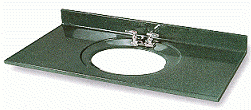Cultured Stone
 Cultured Stone Marble, Granite, Onyx…
Cultured Stone Marble, Granite, Onyx…
Uses: Bath Countertops, Backsplashes, Tub Surrounds, Shower Walls, Wall Panels and Tabletops.
Cultured stone is one of the more popular materials used for bathroom counter-tops. It is both elegant and functional, and comes in a wide variety of colors and styles.
Cultured marble, cultured onyx and cultured granite are basically made of polyester binding resins, pigment and pulverized crushed marble, calcium carbonate or hydrated aluminum (onyx).
The mixture is poured into a mold then coated with a thin polyester gel. A second pour (the underside of the bowl) completes the process and after curing, the product is trimmed, cleaned, ground and polished.
It is rugged with a hard waterproof, stain resistant surface. If it should scratch or chip, the same shops that make them can repair it. Sometimes all that is needed is sanding and polishing.
USE IN THE BATH ONLY: Because cultured stone does not contain quartz, it is softer and less durable than engineered stone. Therefore, it is NOT recommended for use in kitchens or other hard use areas.
Crazing, or the formation of hairline cracks around the drain, used to be a common problem of older models but newer materials have all but eliminated that problem.
The beauty of cultured stone is the ease with which it can be cleaned and polished. To preserve the finish you should apply a protective coat of wax. DO NOT use abrasives like scouring powders; they will take away the shine and dull the surface. Liquid cleaners like Mr. Clean®, Dupont 409®, or Dow® Foaming Cleanser are also good for this product.
Vanity tops can be cast in one piece (up to 12 feet in length) with integral bowls and back splash, minimizing or eliminating seams.
If a cultured marble top has seams, silicone is used to seal the seams, and it is much less likely to leak or mildew than ceramic tile installations that use porous grout. It is the responsibility of the homeowner to inspect and maintain all silicone joints. As houses settle and move, there is the opportunity for the joints to separate. This situation should be corrected as soon as possible so that more serious problems do not develop.

